The Ten Commandments (1956 film)
9.3 /10 2 Votes
91% Rotten Tomatoes Genre Adventure, Drama | 7.9/10 IMDb Duration Language English | |||||||||||||||||||||||||||||||||
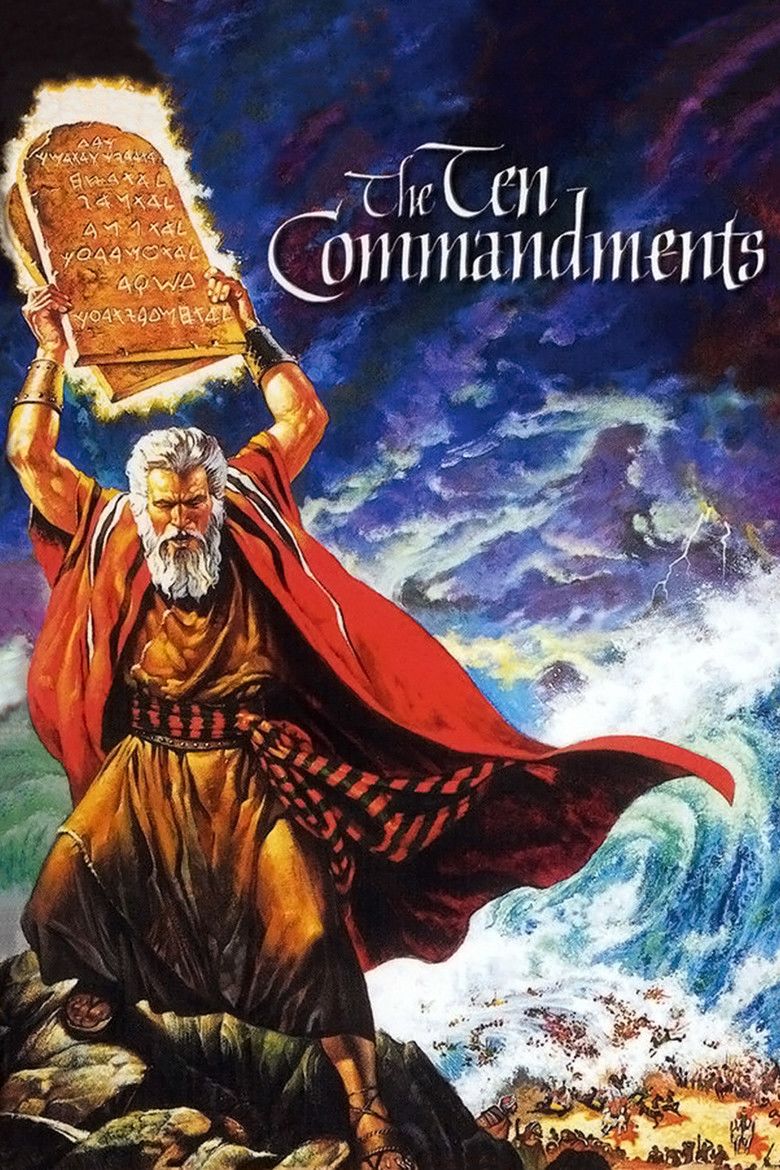 | ||||||||||||||||||||||||||||||||||
Release date October 5, 1956 (1956-10-05) (Salt Lake City preview)November 8, 1956 (1956-11-08) (New York City premiere)November 14, 1956 (1956-11-14) (Los Angeles premiere) Based on Prince of Egypt by Dorothy Clarke WilsonPillar of Fire by J.H. IngrahamOn Eagles Wings by A.E. SouthonThe Holy Scriptures Writer Dorothy Clarke Wilson (this work contains material from the book "Prince of Egypt"), J.H. Ingraham (this work contains material from the book "Pillar of Fire"), A.E. Southon (this work contains material from the book "On Eagles Wing"), AEneas MacKenzie (written for the screen by), Jesse Lasky Jr. (written for the screen by), Jack Gariss (written for the screen by), Fredric M. Frank (written for the screen by) Cast Similar movies The Prince of Egypt , , 12 Years a Slave , The Mummy , The Spy Who Loved Me , Planet of the Apes Tagline The Greatest Event in Motion Picture History | ||||||||||||||||||||||||||||||||||
Moses parts the sea the ten commandments 6 10 movie clip 1956 hd
The Ten Commandments is a 1956 American biblical epic film produced, directed, and narrated by Cecil B. DeMille, shot in VistaVision (color by Technicolor), and released by Paramount Pictures. The film is based on Prince of Egypt by Dorothy Clarke Wilson, Pillar of Fire by J.H. Ingraham, On Eagle's Wings by A.E. Southon, and the Book of Exodus. The Ten Commandments dramatizes the biblical story of the life of Moses, an adopted Egyptian prince who becomes the deliverer of his real brethren, the enslaved Hebrews, and therefore leads the Exodus to Mount Sinai, where he receives, from God, the Ten Commandments. The film stars Charlton Heston in the lead role, Yul Brynner as Rameses, Anne Baxter as Nefretiri, Edward G. Robinson as Dathan, Yvonne De Carlo as Sephora, Debra Paget as Lilia, and John Derek as Joshua; and features Sir Cedric Hardwicke as Sethi, Nina Foch as Bithiah, Martha Scott as Yoshebel, Judith Anderson as Memnet, and Vincent Price as Baka, among others.
Contents
- Moses parts the sea the ten commandments 6 10 movie clip 1956 hd
- The ten commandments 7 10 movie clip moses presents the ten commandments 1956 hd
- Plot
- Cast
- Writing
- Casting
- Art direction
- Special effects
- Music
- Release
- Box office
- Critical response
- Accolades
- Popularity
- Home media
- Television broadcast
- Let my people go the ten commandments 1 10 movie clip 1956 hd
- References
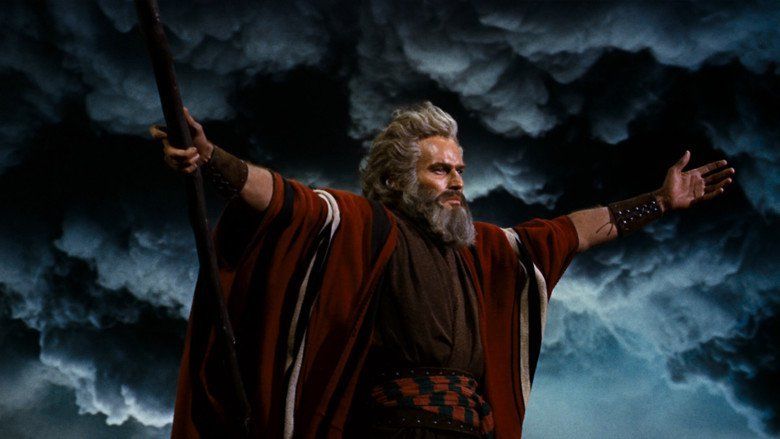
Filmed on location in Egypt, Mount Sinai and the Sinai Peninsula, the film was DeMille's last and most successful work. It is a partial remake of his 1923 silent film of the same title, and features one of the largest sets ever created for a film. The film was released to cinemas in the USA on 5 October 1956 and, at the time of its release, was the most expensive film ever made.

In 1957, the film was nominated for seven Academy Awards including Best Picture, winning the Academy Award for Best Visual Effects (John P. Fulton, A.S.C.). Charlton Heston was nominated for a Golden Globe Award for Best Performance by an Actor in a Motion Picture (Drama) for his role as Moses. Yul Brynner won the National Board of Review Award for Best Actor for his role as Rameses and his other roles in Anastasia and The King and I. It is also one of the most financially successful films ever made, grossing approximately $122.7 million at the box office during its initial release; it was the most successful film of 1956 and the second-highest-grossing film of the decade. According to Guinness World Records, in terms of theatrical exhibition it is the seventh most successful film of all-time when the box office gross is adjusted for inflation.

In 1999, the film was selected for preservation in the United States National Film Registry by the Library of Congress as being "culturally, historically, or aesthetically significant". In June 2008, the American Film Institute revealed its "Ten Top Ten"—the best ten films in ten American film genres—after polling over 1,500 people from the creative community. The film was listed as the tenth best film in the epic genre. Network television has aired the film in prime time during the Passover/Easter season every year since 1973. Among the credited actors in the movie still alive are Debra Paget, Fraser C Heston, Mimi Gibson, Eugene Mazzola, Lisa Mitchell, Clint Walker and Joanna Merlin.
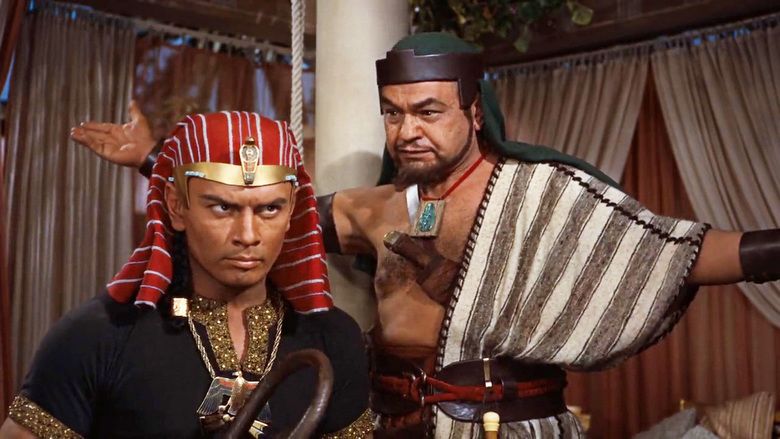
The ten commandments 7 10 movie clip moses presents the ten commandments 1956 hd
Plot
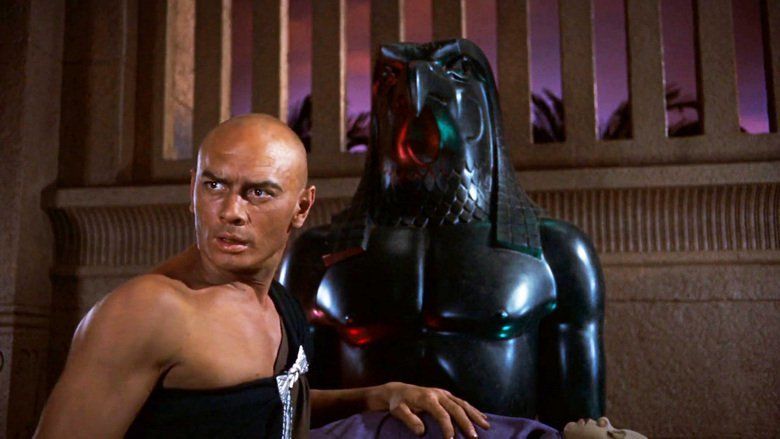
Pharaoh Rameses I of Egypt has ordered the death of all firstborn Hebrew males, but Yoshebel saves her infant son by setting him adrift in a basket on the Nile. Bithiah, the Pharaoh's daughter, finds the basket and decides to adopt the boy even though her servant, Memnet, recognizes the child is Hebrew. Bithiah names the baby Moses.
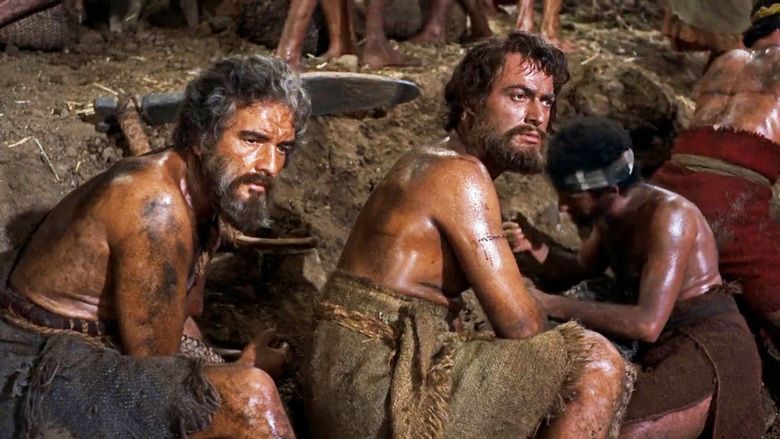
Prince Moses grows up to become a successful general, winning a war with Ethiopia and establishing an alliance. Moses loves princess Nefretiri, who must marry the next Pharaoh. She reciprocates his love. While working on the building of a city for Pharaoh Sethi's jubilee, Moses meets the stonecutter Joshua, who tells him of the Hebrew God. Moses saves an elderly woman from being crushed, and he scolds the overseer Baka. Moses does not know that the woman is his biological mother, Yoshebel.
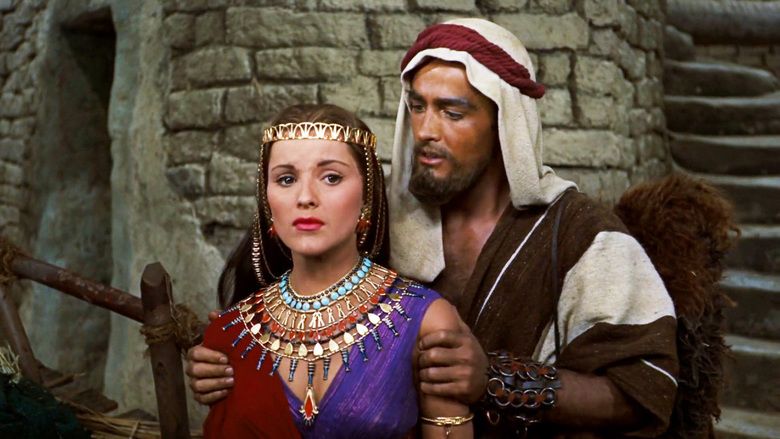
Moses reforms the treatment of slaves on the project, but Prince Rameses, Moses's "brother", charges him with planning an insurrection. Moses says he is making his workers more productive. Rameses wonders if Moses is the man the Hebrews are calling the Deliverer.

Nefretiri learns from Memnet that Moses is the son of Hebrew slaves. Nefretiri kills Memnet but reveals the story to Moses only after he finds the piece of Levite cloth he was wrapped in as a baby, which Memnet had kept. Moses follows Bithiah to Yoshebel's house where he meets his birth mother and family.
Moses learns more about the slaves by working with them. Nefretiri urges him to return to the palace so he may help his people when he becomes pharaoh, to which he agrees after he completes a final task. Moses saves Joshua from death by strangling Baka, telling Joshua that he too is Hebrew. The confession is witnessed by the overseer Dathan. Dathan tells Rameses, who then arrests Moses. Moses explains that he is not the Deliverer, but would free the slaves if he could. Rameses is declared the next Pharaoh. Rameses banishes Moses to the desert.
Moses makes his way across the desert to a well in Midian. He defends seven sisters from Amalekites. He is housed with the girls' father Jethro, a Bedouin sheik, who worships the God of Abraham. Moses marries Jethro's eldest daughter Sephora.
Moses finds Joshua, who has escaped hard labor. Moses sees the burning bush on the summit of Mount Sinai and hears the voice of God. Moses returns to Egypt to free the Hebrews.
Moses comes before Rameses, now pharaoh, to win the slaves' freedom, turning his staff into a cobra. Jannes performs the same trick with his staves, but Moses's snake is superior. Rameses prohibits straw from being provided to the Hebrews to make their bricks. Nefretiri rescues Moses from being stoned to death by the Hebrews. He tells her he is married.
Egypt is visited by plagues. Moses turns the river Nile to blood at a festival of Khnum and brings burning hail down upon Pharaoh's palace. Moses warns him the next plague to fall upon Egypt will be summoned by Pharaoh himself. Enraged at the plagues, Rameses orders all first-born Hebrews to die. Instead, a cloud of death kills all the firstborn of Egypt, including the child of Rameses and Nefretiri. Angrily, Pharaoh exiles the Hebrews, which begins the Exodus from Egypt.
Rameses takes his army and pursues the Hebrews to the Red Sea. Moses uses God's help to stop the Egyptians with a pillar of fire. Moses parts the Red Sea and the Hebrews struggle toward the other side. Moses releases the walls of water, drowning the Egyptian army. Rameses returns empty-handed to Nefretiri, telling her, "His god is God".
Moses again ascends the mountain with Joshua. Impatiently, Dathan urges the Hebrews to construct a golden calf idol as a gift for Rameses. A wild and decadent orgy is held by most of the Hebrews.
Moses sees the Ten Commandments created by God in two stone tablets. Moses descends from the mountain to the sight of decadence. He throws the tablets at the golden calf, which explodes, killing the wicked revelers.
Forty years later, an elderly Moses leads the Hebrews to Canaan. He names Joshua as leader, and walks alone out of Israel.
Cast
Writing
The final shooting script was written by Aeneas MacKenzie, Jesse L. Lasky Jr., Jack Gariss, and Fredric M. Frank. It also contained material from the books Prince of Egypt by Dorothy Clarke Wilson, Pillar of Fire by Joseph Holt Ingraham, and On Eagle's Wings by Arthur Eustace Southon. Henry Noerdlinger, the film's researcher, consulted ancient historical texts such as the Midrash Rabbah, Philo's Life of Moses, and the writings of Josephus and Eusebius in order to "fill in" the missing years of Moses' life, and as the film's last opening title card states, "the Holy Scriptures."
Casting
Charlton Heston, who had previously worked with DeMille in The Greatest Show on Earth, won the part of Moses after he impressed DeMille (at his audition) with his knowledge of ancient Egypt. Interestingly enough, William Boyd, DeMille's first choice to be auditioned to be Moses in the film, refused the part. Heston was also chosen to be the voice of God in the form of a burning bush, toned down to a softer and lower register.
Heston's newborn son, Fraser (born February 12, 1955), was cast by DeMille (on the suggestion of Henry Wilcoxon, who said to him "The timing's just right. If it's a boy, who better to play the Baby Moses?") as soon as Heston announced to DeMille that his wife Lydia was pregnant. Fraser Heston was three months old during filming.
The part of Nefretiri, the Egyptian throne princess, was considered "the most sought after role of the year" in 1954. Ann Blyth, Vanessa Brown, Joan Evans, Rhonda Fleming, Coleen Gray, Jane Griffiths, Audrey Hepburn, Jean Marie, Vivien Leigh, Jane Russell, and Joan Taylor were considered for the part. DeMille liked Audrey Hepburn but dismissed her because of her figure, which was considered too slim for the character's Egyptian gowns. Anne Baxter (who was considered for the part of Moses' wife) was cast in the role.
Judith Ames, Anne Bancroft, Anne Baxter, Shirley Booth, Diane Brewster, Peggie Castle, June Clayworth, Linda Darnell, Laura Elliot, Rhonda Fleming, Rita Gam, Grace Kelly, Jacqueline Green, Barbara Hale, Allison Hayes, Frances Lansing, Patricia Neal, Marie Palmer, Jean Peters, Ruth Roman, Barbara Rush, and Elizabeth Sellers were considered for the part of Sephora. Grace Kelly, DeMille's first choice, was unavailable. DeMille was "very much impressed" with Yvonne De Carlo's performance as a "saintly type of woman" in MGM's Sombrero. He "sensed in her a depth, an emotional power, a womanly strength which the part of Sephora needed and which she gave it." Sephora is the Douay–Rheims version of the name of Zipporah.
Merle Oberon and Claudette Colbert were considered for the role of Bithiah before DeMille chose Jayne Meadows (who declined) and finally cast Nina Foch, on the suggestion of Henry Wilcoxon, who had worked with her in Scaramouche.
For the role of Memnet, Flora Robson was considered and Bette Davis was interviewed (DeMille's casting journal also notes Marjorie Rambeau and Marie Windsor) but DeMille chose Judith Anderson after screening Alfred Hitchcock's Rebecca.
Henry Wilcoxon's wife Joan Woodbury was cast as Korah's wife in the Golden Calf sequence.
DeMille was reluctant to cast anyone who had appeared in 20th Century Fox's The Egyptian, a rival production at the time. Several exceptions to this are the casting of John Carradine and Mimi Gibson (in credited supporting roles) and Michael Ansara and Peter Coe (in uncredited minor roles), who appeared in both films.
For the Large Crowd shots, at least 14,000 extras and 15,000 animals were used while filming this movie.
Art direction
Commentary for the film's DVD edition chronicles the historical research done by DeMille and associates. Katherine Orrison says that many details of Moses' life left out of the Bible are present in the Quran, which was sometimes used as a source. She also presents some coincidences in production. The man who designed Moses' distinctive rust-white-and-black-striped robe used those colors because they looked impressive, and only later discovered that these are the actual colors of the Tribe of Levi. Arnold Friberg would later state that he was the one who designed Moses' costume. As a gift, after the production, DeMille gave Moses' robe to Friberg, who had it in his possession until his death in 2010. Moses' robe as worn by Charlton Heston was hand-woven by Dorothea Hulse, one of the world's finest weavers. She also created costumes for The Robe, as well as textiles and costume fabrics for Samson and Delilah, David and Bathsheba, and others.
Jesse Lasky Jr., a co-writer on The Ten Commandments, described how DeMille would customarily spread out prints of paintings by Lawrence Alma-Tadema to inform his set designers on the look he wanted to achieve. Arnold Friberg, in addition to designing sets and costumes, also contributed the manner in which Moses ordained Joshua to his mission at the end of the film: by the laying on of hands, placing his hands on Joshua's head. Friberg, a member of The Church of Jesus Christ of Latter-day Saints, demonstrated the LDS manner of performing such ordinations, and DeMille liked it.
Pharaoh is usually shown wearing the red-and-white crown of Upper and Lower Egypt or the nemes royal headdress. For his pursuit of the Israelites, he wears the blue Khepresh helmet-crown, which the pharaohs wore for battle.
Sets, costumes and props from the film The Egyptian were bought and re-used for The Ten Commandments. As the events in The Egyptian take place 70 years before the reign of Rameses II, an unintentional sense of continuity was created.
An Egyptian wall painting was also the source for the lively dance performed by a circle of young women at Seti's birthday gala. Their movements and costumes are based on art from the Tomb of the Sixth Dynasty Grand Vizier Mehu. Some of the film's cast members, such as Baxter, Paget, Derek, and Foch, wore brown contact lenses, at the behest of DeMille, in order to conceal their light-colored eyes which were considered inadequate for their roles. Paget once said that, "If it hadn't been for the lenses I wouldn't have got the part." However, she also said that the lenses were "awful to work in because the kleig lights heat them up". When DeMille cast Yvonne De Carlo as Sephora, she was worried about having to wear these contact lenses; she also believed that her gray eyes were her best feature. She asked DeMille to make an exception for her. He agreed, expressing the idea that De Carlo's role was special, and that Moses was to fall in love with her.
Special effects
The special photographic effects in The Ten Commandments were created by John P. Fulton, A.S.C. (who received an Academy Award for his effects in the film), head of the special effects department at Paramount Pictures, assisted by Paul Lerpae, A.S.C. in Optical Photography (blue screen "travelling matte" composites) and Farciot Edouart, A.S.C., in Process Photography (rear projection effects). Fulton’s effects included the building of Sethi’s Jubilee treasure city, the Burning Bush, the fiery hail from a cloudless sky, the Angel of Death, the composites of the Exodus, the Pillar of Fire, the giving of the Ten Commandments, and the tour de force, the parting of the Red Sea. The parting of the Red Sea was considered the most difficult special effect ever performed up to that time. This effect took about six months of VistaVision filming, and combined scenes shot on the shores of the Red Sea in Egypt, with scenes filmed at Paramount Studios in Hollywood of a huge water tank split by a U-shaped trough, into which approximately 360,000 gallons of water were released from the sides, as well as the filming of a giant waterfall also built on the Paramount backlot to create the effect of the walls of the parted sea out of the turbulent backwash. All of the multiple elements of the shot were then combined in Paul Lerpae's optical printer, and matte paintings of rocks by Jan Domela concealed the matte lines between the real elements and the special effects elements. Unlike the technique used by ILM for Raiders of the Lost Ark and Poltergeist of injecting poster paints into a glass tank containing a salt water inversion layer, the cloud effects for The Ten Commandments were formed with white Britt smoke filmed against a translucent sky backing, and colors were added optically. Striking portraits of Charlton Heston as Moses and three women in front of menacing clouds were photographed by Wallace Kelly, A.S.C. in Farciot Edouart’s process (rear projection) department, in what are still considered unforgettable scenes. DeMille used these scenes to break up the montage, framing his subjects like a Renaissance master. An abundance of blue screen spillage or "bleeding" can be seen, particularly at the top of the superimposed walls of water, but rather than detracting from the shot, this (unintentionally) gives the scene an eerie yet spectacular appearance. The parting of the Red Sea sequence is considered by many to be one of the greatest special effects of all time.
DeMille was reluctant to discuss technical details of how the film was made, especially the optical tricks used in the parting of the Red Sea. It was eventually revealed that footage of the Red Sea was spliced with film footage (run in reverse) of water pouring from large U-shaped trip-tanks set up in the studio backlot.
Music
The score for The Ten Commandments was composed and conducted by Elmer Bernstein. Initially, DeMille hired Bernstein, then a relatively unknown film composer, to write and record only the diegetic music required for the film's dance sequences and other onscreen musical passages, with the intention of employing frequent collaborator Victor Young to write the score proper. However, Young turned down the assignment due to his own failing health, causing DeMille to hire Bernstein to write the underscore as well.
In total, Bernstein composed two and a half hours of music for the film, writing for a full symphony orchestra augmented with various ethnic and unusual instruments such as the shofar, the tiple, and the theremin. The score is written in a highly Romantic style, featuring unique musical leitmotifs for the film's characters (God, Moses, Rameses, Nefretiri, etc.) used in a manner inspired, at DeMille's direction, by the opera scores of Richard Wagner. Bernstein recorded both the diegetic music and the score at the Paramount Studios Recording Stage in sessions spread from April 1955 to August 1956.
A double-LP monaural soundtrack album was released in 1957 by Dot Records, utilizing excerpts from the original film recordings. A stereo version of the 1957 album was released in 1960 containing new recordings conducted by Bernstein, as the original film recordings, while recorded in three-channel stereo, were not properly balanced for an LP stereo release, as the intent at the time of recording had been to mix the film masters to mono for the film soundtrack itself; this recording was later issued on CD by MCA Classics in 1989. For the film's tenth anniversary, United Artists Records released a second stereo re-recording in 1966, also conducted by Bernstein and employing different orchestral arrangements unique to this release.
For the film's 60th anniversary, Intrada Records released a 6-CD album of the score in 2016. The Intrada release contains the complete two and a half hour score as originally recorded by Bernstein, with much of it remixed in true stereo for the first time. In addition, the 2016 release contains all the diegetic music recorded for the film, the original 1957 Dot album (in mono), the 1960 Dot album (in stereo), and the 1966 United Artists album, as well a 12-minute recording of Bernstein auditioning his thematic ideas for DeMille on the piano.
Release
The Ten Commandments premiered at New York City's Criterion Theatre on November 8, 1956. Among those who attended the premiere were Cecil B. DeMille and his daughter Cecilia DeMille Harper, Charlton Heston and his wife Lydia Clarke, Yul Brynner, Anne Baxter, Edward G. Robinson, Yvonne De Carlo and her husband Bob Morgan, Martha Scott and her husband and son, John Wayne and his wife Pilar Pallete, Tony Curtis, Janet Leigh, and Barney Balaban. It played on a roadshow basis with reserved seating until mid-1958, when it finally entered general release. It was re-released in 1966 and 1972, and one more time in 1989. The 1972 and 1989 re-issues included 70mm and 35mm prints that reframed the picture's aspect ratio to 2.20:1 and 2.35:1, respectively, cropping the top and bottom of the picture's original 1.85:1 aspect ratio. The Ten Commandments was released on DVD on March 30, 1999; March 9, 2004, as a Special Collector's Edition; and March 29, 2011, as a Special edition and Standard edition.
Box office
The Ten Commandments was the highest-grossing film of 1956 and the second most successful film of the decade. By April 1957, the film had earned an unprecedented $10 million from engagements at just eighty theaters, averaging about $1 million per week, with more than seven million people paying to watch it. During its initial release, it earned theater rentals (the distributor's share of the box office gross) of $31.3 million in North America and $23.9 million from the foreign markets, for a total of $55.2 million (equating to approximately $122.7 million in ticket sales). It was hugely profitable for its era, earning a net profit of $18,500,000, against a production budget of $13.27 million (the most a film had cost up to that point).
By the time of its withdrawal from distribution at the end of 1960, The Ten Commandments had overtaken Gone with the Wind at the box office in the North American territory, and mounted a serious challenge in the global market—the worldwide takings for Gone with the Wind were reported to stand at $59 million at the time. Gone with the Wind would be re-released the following year as part of the American Civil War Centennial, and reasserted its supremacy at the box office by reclaiming the US record. Also at this time, Ben-Hur—another biblical epic starring Charlton Heston released at the end of 1959—would go on to eclipse The Ten Commandments at the box office. A 1966 reissue earned $6,000,000, and further re-releases brought the total American theater rentals to $43 million, equivalent to gross ticket sales of $89 million at the box office. Globally, it ultimately collected $90,066,230 in revenues up to 1979.
It remains one of the most popular films ever made. Adjusted for inflation, it has earned a box office gross equivalent to $2 billion at 2011 prices, according to Guinness World Records; only Gone with the Wind (1939), Avatar (2009), Star Wars (1977), Titanic (1997), The Sound of Music (1965), and E.T. the Extra-Terrestrial (1982) have generated higher grosses in constant dollars.
Critical response
The Ten Commandments received generally positive reviews after its release, although some reviewers noted its divergence from the biblical text. Bosley Crowther for The New York Times was among those who lauded DeMille's work, acknowledging that "in its remarkable settings and décor, including an overwhelming facade of the Egyptian city from which the Exodus begins, and in the glowing Technicolor in which the picture is filmed—Mr. DeMille has worked photographic wonders." Variety described the "scenes of the greatness that was Egypt, and Hebrews by the thousands under the whip of the taskmasters" as "striking," and believed that the film "hits the peak of beauty with a sequence that is unelaborate, this being the Passover supper wherein Moses is shown with his family while the shadow of death falls on Egyptian first-borns."
The film's cast was also complimented. Variety called Charlton Heston an "adaptable performer" who, as Moses, reveals "inner glow as he is called by God to remove the chains of slavery that hold his people." It considered Yul Brynner "expert" as Rameses, too. Anne Baxter's performance as Nefretiri was criticized by Variety as leaning "close to old-school siren histrionics," but Crowther believed that it, along with Brynner's, is "unquestionably apt and complementary to a lusty and melodramatic romance." The performances of Yvonne De Carlo and John Derek were acclaimed by Crowther as "notably good." He also commended the film's "large cast of characters" as "very good, from Sir Cedric Hardwicke as a droll and urbane Pharaoh to Edward G. Robinson as a treacherous overlord."
Leonard Maltin, a contemporary film critic, gave the film four out of four stars and described it as "vivid storytelling at its best... parting of the Red Sea, writing of the holy tablets are unforgettable highlights."
Rotten Tomatoes retrospectively collected 33 reviews and gave the film a rating of 94% "Certified fresh" approval rating, with an average rating of 7.5/10 and the site's consensus stating: "Bombastic and occasionally silly but extravagantly entertaining, Cecil B. DeMille's all-star spectacular is a muscular retelling of the great Bible story."
Camille Paglia has called The Ten Commandments one of the ten greatest films of all time.
Accolades
The Ten Commandments won the Academy Award for Best Special Effects (John P. Fulton). It was also nominated for Best Color Art Direction (art directors Hal Pereira, Walter H. Tyler, and Albert Nozaki and set decorators Sam Comer and Ray Moyer), Best Color Cinematography (Loyal Griggs), Best Color Costume Design (Edith Head, Ralph Jester, John Jensen, Dorothy Jeakins, and Arnold Friberg), Best Film Editing (Anne Bauchens), Best Motion Picture (Cecil B. DeMille) and Best Sound Recording (Paramount Studio Sound Department and sound director Loren L. Ryder). Paramount submitted the names of Yvonne De Carlo, John Derek, and Debra Paget for the supporting player categories (even though they received star billing in the film) at the 29th Academy Awards, but the actors did not receive nominations.
Charlton Heston's performance as Moses was ranked as the 4th Best Performance by a Male Star of 1956 by The Film Daily's Filmdom's Famous Five Poll. Heston was also nominated for a Golden Globe Award for Best Performance by an Actor in a Motion Picture - Drama and later won the Fotograma de Plata Award for Best Foreign Performer in 1959.
Yul Brynner won the National Board of Review Award for Best Actor for his performance as Rameses.
Cecil B. DeMille won many special awards for the film. He received, among others, the Los Angeles Examiner Award, the Boxoffice Blue Ribbon Award for the Best Picture of the Month (January 1957), the Photoplay Achievement Award, and The Christian Herald's Reader's Award for the Picture of the Year (1957).
The Maryland State Council of the American Jewish Congress awarded the Stephen S. Wise Medallion to DeMille for "most inspiring film of the year." Charlton Heston, Yul Brynner, Edward G. Robinson, Sir Cedric Hardwicke, Nina Foch, and Martha Scott also received awards for their acting.
The film was also included in several of the annual top ten film lists, such as those featured in The Film Daily and Photoplay.
The American Film Institute included the film as #10 in the epic film category in AFI's 10 Top 10, #79 in AFI's 100 Years...100 Cheers, and named Moses as the #43 hero in AFI's 100 Years...100 Heroes and Villains.
Popularity
Critics have argued that considerable liberties were taken with the biblical story of Exodus, compromising the film's claim to authenticity, but neither this nor its nearly four-hour length has had any effect on its popularity. In fact, many of the supposed inaccuracies were actually adopted by DeMille from extra-biblical ancient sources, such as Josephus, the Sepher ha-Yashar, and the Chronicle of Moses. Moses's career in Ethiopia, for instance, is based on ancient midrashim. For decades, a showing of The Ten Commandments was a popular fundraiser among revivalist Christian Churches, while the film was equally treasured by film buffs for DeMille's "cast of thousands" approach and the heroic but antiquated early-talkie-type acting.
Home media
The Ten Commandments has been released on DVD in the United States on four occasions: the first edition (Widescreen Collection) was released on March 30, 1999 as a two-disc set, the second edition (Special Collector's Edition) was released on March 9, 2004, as a two-disc set with commentary by Katherine Orrison, the third edition (50th Anniversary Collection) was released on March 21, 2006 as a three-disc set with the 1923 version and special features, and the fourth edition (55th Anniversary Edition) was released on DVD again in a two-disc set on March 29, 2011, and for the first time on Blu-ray in a two-disc set and a six-disc limited edition gift set with the 1923 version and DVD copies. In 2012, the limited edition gift set won the Home Media Award for Best Packaging (Paramount Pictures and JohnsByrne).
Television broadcast
With the exception of 1999, this film has been broadcast annually on the ABC network since 1973, traditionally during the Passover and Easter holidays. For much of that period ABC has aired it on the evening of Easter Sunday.
Unlike many lengthy films of the day, which were usually broken up into separate airings over at least two nights, ABC elected to show the entire film in one night and has done so every year it has carried The Ten Commandments, with one exception; in 1997, ABC elected to split the movie in two and aired half of it in its normal Easter Sunday slot, which that year was March 30, with the second half airing on Monday, March 31 as counterprogramming to the other networks' offerings, which included CBS' coverage of the NCAA Men's Basketball Championship Game.
The length of the film combined with the necessary advertisement breaks has caused its broadcast window to vary over the years, and today, ABC's total run time for The Ten Commandments stands at four hours and forty-four minutes. This requires the network to overrun into the 11:00 pm/10:00 pm CT/MT timeslot that belongs to the local affiliates, thus delaying their late local news and any other programming the station may air in the overnight hours (with some stations forgoing a late newscast entirely and giving personnel the evening off). When the film has aired on Easter Sunday, the local ABC affiliates are given the ability to tape delay the showing an hour ahead to 8 p.m. ET/PT to keep their schedules in line for early evening (though at the cost of delaying their local newscasts to around 1:00 a.m./midnight CT/MT).
In more recent years, ABC chose to air other programming on Easter night and instead aired The Ten Commandments the night before as part of its Saturday night lineup, with the broadcast starting at 8:00 pm Eastern. In 2015, for the first time in several years, the network returned to airing the film on Easter Sunday night, which fell on April 5. In 2016 ABC's broadcast returned to Saturday, thereby allowing affiliates the option of airing the film at 7:00/6:00 CT/MT or 8:00/7:00 CT/MT. It is thus the only pre-scheduled ABC Saturday Movie of the Week title in that film series yearly.
In 2010, the film was broadcast in high definition for the first time, which allowed the television audience to see it in its original VistaVision aspect ratio.
Let my people go the ten commandments 1 10 movie clip 1956 hd
References
The Ten Commandments (1956 film) WikipediaThe Ten Commandments (1956 film) IMDbThe Ten Commandments (1956 film) Rotten TomatoesThe Ten Commandments (1956 film) themoviedb.org
